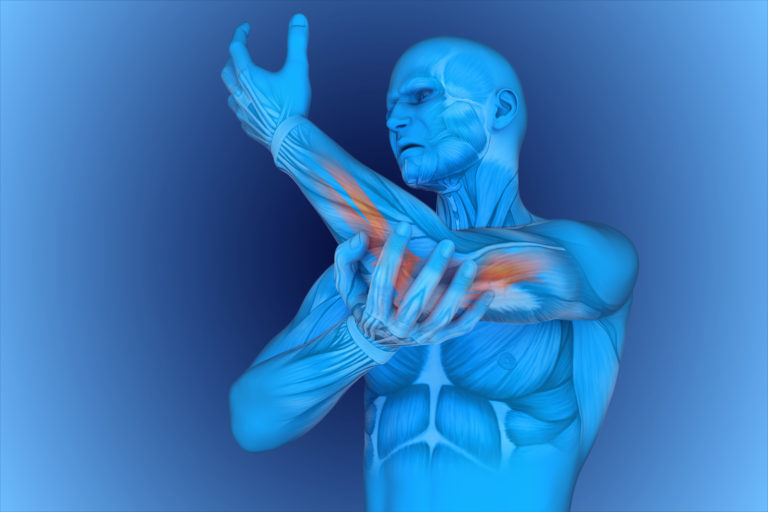
Tennis elbow (lateral epicondylitis) has been sidelining athletes for decades with sharp elbow pain. Commonly thought of as an over use injury, I seem to be treating this problem more frequently over the past few years. Previously, I saw this problem mainly with athletes and racquet sport players, but this problem has become more prevalent in the general population. This is perhaps due to an aging population or a trend towards more active lifestyles.
What is Tennis Elbow?
Generally speaking it is a tendinopathy (tendon problem) at the origin of the extensor carpi radialis brevis muscle, one of the wrist extensor muscles. This muscle allows you to extend the wrist and fingers. Extend your arms straight out in front of you with your palms down, now point your fingers to the ceiling, that upwards motion of the wrist is “wrist extension”. In tennis, as well as other racquet sports, repetitive wrist extension is a dominant movement, hence the high prevalence and common reference of “Tennis elbow”. It could just as easily be named “racquet elbow” but poor tennis somehow got the blame. The site of injury is typically the lateral epicondyle, a bony bump on the outside of the elbow where these muscles/tendons attach.
What Causes Tennis Elbow?
Research has shown that this problem is due to degenerative changes rather than an inflammatory process. Often we associate inflammation with most forms of tendonitis, but not in this case. The simple explanation was also “you overuse your wrist extensors and it is causing inflammation” – This does not cut it anymore, we now know that there is generally NOT the same inflammatory chemicals we see in tendonitis when we look at people with tennis elbow. It is now looked at as more of a degenerative condition, coupled with changes in the blood supply, and changes in the coordination of the muscles when using the hand and wrist. You also see degenerative changes in the extensor tendon, where the tendon structure starts to break down.
There is also evidence that longstanding forearm muscle imbalances can distort your elbow joint position and result in chronic tennis elbow pain. This results in decreased ability to perform normal elbow activities and reducing elbow and grip strength. It seems like it comes back to the way we control movement – This is why movement based assessment assessing control and competency are so valuable. Common causes include, as you could guess, repetitive wrist extension and forearm rotation. I treat this issue in athletes who perform multiple sets of dips, push ups, and chin ups. In addition, tennis elbow can present if a person’s job involves extensive periods of repetitive motion at the elbow and wrist. I often see this in carpenters and manual labourers who use heavy power tools. One of the hall mark symptoms we look for is decreased grip strength. Patients often complain of not being able to use their racquets or tools well, primarily due to pain and a substantial lack of grip strength. This affects performance and the ability to be competitive.
How to Treat Tennis Elbow
There are many treatments that I have found to be extremely effective in treating tennis elbow:
• Stop aggravating it! Unfortunately, for athletes this is hard and does likely require missing time, as much as they hate to hear it.
• Wear a brace for 4-6 weeks. Specific bracing recommendations in terms of frequency and style should be made on an individual basis in the clinic. We have access to a wide variety of braces.
• Acupuncture treatments have shown to be quite effective in treating tennis elbow. Typically 2 visits a week for a 3-4 week period.
• Physiotherapy/massage targeting the overworked or tightened extensor group to release and reset the tissue.
• Anti-inflammatory medications can be used if steps one through four are not effective. Discuss with your doctor first.
• Considering a corticosteroid injection, if all the above does not work should be the next step. Some studies now indicate that the steroid injection has a similar effect as a placebo; however, I have seen some patients do very well with them.
• Currently, platelet-rich plasma (PRP) injections are also being used. Unfortunately, as the treatment is relatively new, there is not enough research to say if this is effective or not. Anecdotally, the patients that I have seen go on to receive PRP injections and combine it with physio and the appropriate rehab have done fantastic.
Assessment is key:
Determining the root cause of the dysfunction is always the most important step. If an otherwise strong/healthy athlete suffers from tennis elbow it is likely due to over training, poor form or an inefficient movement in the upper limb. With a proper assessment we should be able to determine what needs to be modified and/or corrected in order to prevent this issue from returning. To be clear, I am not talking about modifying swing technique etc, but rather, for example, perhaps the athlete lacks scapular stability and as a result demonstrates poor control of the whole arm. This is bound to put undue stress on the larger muscles of the forearm and could contribute too many problems, tennis elbow being one of them. This could be identified with a thorough sport specific assessment and specific rehabilitation exercises prescribed. A quality assessment is always available at OMNI; please do not hesitate to stop by the clinic with any questions.




